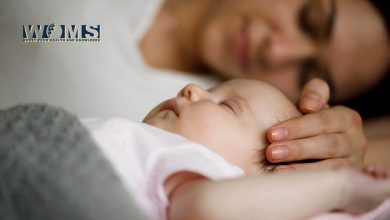Perinatal asphyxia

Perinatal asphyxia (PNA) is a clinical condition resulting from impairment of gas exchange in the foetus leading to hypoxia, hypercarbia and acidosis. This ultimately culminates into failure to establish and sustain spontaneous respiration immediately after birth.
Gas Exchange: Foetal to Neonatal transition
Normally, in utero, the placenta provides O2 to the foetus and removes CO2, from the foetus. After birth, the lungs of the newborn take over the responsibility and to do it efficiently, the following 3 changes occur after birth-
- Replacement of alveolar fluid by air with the onset of breathing
- Rise of pressure in systemic circulation by constriction of umbilical vessels
- Fall of pressure in the pulmonary vascular bed
Majority of newborn babies pass through these changes smoothly without any intervention. However, some babies cannot pass this transition without help. As a result, they may face acute hypoxic insult and this incapacitating them to breathe spontaneously.
Stimuli to initiate respiration at birth
- Decreased PaO2, the rise of PaCO2, & fall of blood pH
- Redistribution of cardiac output
- Decreased body temperature
- Various tactile and sensory stimuli
The risk factor of perinatal asphyxia (PNA)
- Maternal illnesses
- Hypertension
- Prolonged/Obstructed labour
- Eclampsia
- Diabetes
- Hypotension
- Anaemia
- Uterine rupture
- Systemic disease
- Placental pathology
- Abruptio placentae
- Umbilical cord accidents
- Prolapse
- Knot
- Cord around the neck
- Compression
- Foetal illnesses
- Anaemia
- Infection
- Severe cardiac malformations/insufficiency
- Neonatal illnesses
- Congenital malformation of lungs or heart
- Persistent pulmonary hypertension
- Cardiomyopathy
Pathogenesis and consequences
When a foetus faces acute hypoxia in utero (antepartum or intrapartum), then certain cardio-respiratory and biochemical sequence of events occur. Initially, breathing effort increases but continuing hypoxia makes the foetus unconscious and finally, the respiratory centre stops functioning. The foetus thus enters into the stage of primary apnoea which, if remains unattended, agonal gasps ensue, culminating in terminal apnoea.
Concomitant to these respiratory events, other changes also occur in-
- Heart: Heart rate drops down after a brief initial rise. Cardiac output is redistributed with a preference for maintaining perfusion of heart, brain and adrenals
Accumulation of CO2 and Lactic acids (bi-product of anaerobic metabolism) leads to increasing acidosis which further deteriorates cardiac functions and finally heart stop.
Therefore, a baby who fails to breathe spontaneously immediately after birth may be either in primary apnoea, gasping respiration or in terminal apnoea and Resuscitation is the only way to save these babies.
The most serious consequence of Perinatal asphyxia is Hypoxic Ischaemic Encephalopathy (HIE). However, other organs may also be affected, particularly-
Clinical manifestation of PNA
- The asphyxiated baby presents with-
- No respiration, no cry
- Absent or weak respiratory efforts
- Gasping respiration with long pauses in between respirations
- Convulsions (HIE)
- Pale colour (asphyxia pallid)
- Bradycardia (<100 beats/min)
- Less tissue perfusion (capillary refill time >3 sec)
- Muscular hypotonia
- Features of acute kidney injury e.g oliguria
Management of perinatal asphyxia (PNA)
The management of PNA is discussed below under different headings:
- Effective resuscitation at birth, the cornerstone of management
- Post-Resuscitation care
Resuscitation: Preparation
- Person: At least one person trained in newborn resuscitation
- Warm environment: By closing windows, minimizing draughts, pre-warming towels, head covering for the baby, heater/radiant warmer
- Resuscitation surface: Arrange flat & firm surface
- Resuscitation equipment:
- Self-inflating bag with a correct sized mask
- Oxygen source
- Pulse-oximeter with probe Intubation equipment: Laryngoscope with straight blades, endotracheal tubes
- Drugs: Adrenaline (1:10,000), Naloxone, 10% D/A, 0.9% NaCI
- Others:
- Stethoscope
- Suction apparatus
- Umbilical venous catheter
- Suction tube
Resuscitation at birth
It is a set of interventions, required at the time of birth to support establishing breathing and circulation. The interventions support of perinatal asphyxia is to achieve normal transition rather than imposing an alternate process
- Appraise baby’s risk for requiring resuscitation accommodate warmth Position, clear airway Dry, stimulate to breathe
- Give supplemental oxygen, as necessary
- Assist ventilation with positive pressure
- Intubate the trachea
- Provide chest compressions
- Administer medications
The key points are-
- Keep the baby warm by
- Immediate drying and wrapping the baby including head with a dry warm towel
- Providing a room heater, if available
- Open and maintain an airway by
- Keeping the baby in neutral airway position (neither over-extension nor hyperflexion of the neck)
- Chin lift & jaw-thrust
- Placing a roll of towel (2 cm) under the baby’s shoulders
- Clearing the airway by gentle suction
- Support breathing by
- Stimulating the baby e.g. rubbing the back gently, slapping or flicking the soles of the feet
- Positive pressure ventilation using Bag and Mask with or without an endotracheal tube
- Maintain oxygenation and circulation by
- Chest compression and coordinated positive pressure ventilation
- Mechanical ventilation
post-resuscitation management
- Maintain body temperature (mentioned earlier)
- Support respiration by-
- Supplemental O2, by nasal cannula (2 L/min), headbox (5-6 L/min)
- Mechanical ventilation
- Maintain adequate hydration, electrolyte, calcium and glucose homeostasis by
- Infusion of appropriate IV fluid with 10-20% restriction of total daily allowance
- Regular monitoring of
- Respiratory status:
- Respiratory rate
- Cyanosis
- Rhythm & pattern
- Circulatory status:
- Heart rate
- BP
- CRT
- Renal functional status:
- Urine volume
- creatinine (learn about: how to reduce creatinine level effectively)
- Capillary blood glucose status
- Arterial blood gas (ABG) analysis, when needed
- Respiratory status:
-
Treatment of specific situations
- If shock (CRT: >3 sec, pulse volume: low, BP: low): Infuse Normal Saline bolus, 10 ml/kg
over 30 min. Give Dopamine/Dobutamine, 5-10 μgm/kg/min - If convulsion: Control as per protocol
- If sepsis: Parenteral broad-spectrum antibiotics
- If shock (CRT: >3 sec, pulse volume: low, BP: low): Infuse Normal Saline bolus, 10 ml/kg
Prognosis
- Overall mortality: 10-30 %. Among the survivors, 15-45% may develop the following neurodevelopmental sequelae
- Cerebral palsy
- Cranial nerve palsy
- Epilepsy/seizure disorders
- Intellectual disability
- Deafness
- Visual problems
- Microcephaly




